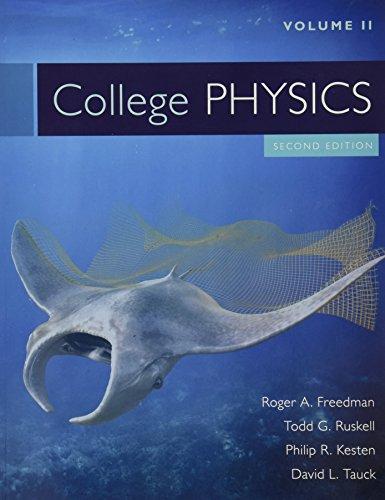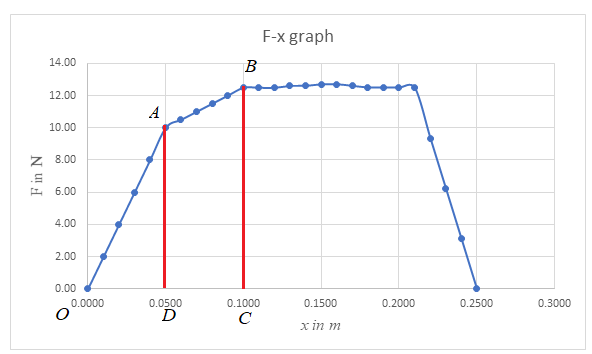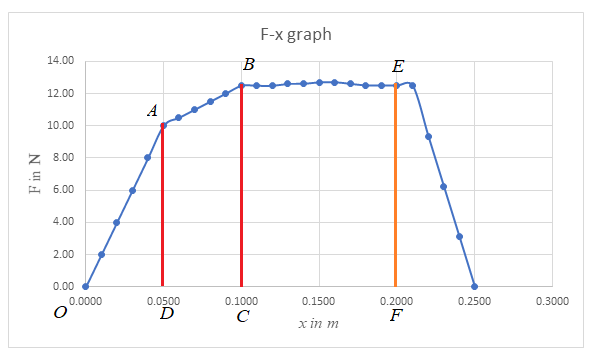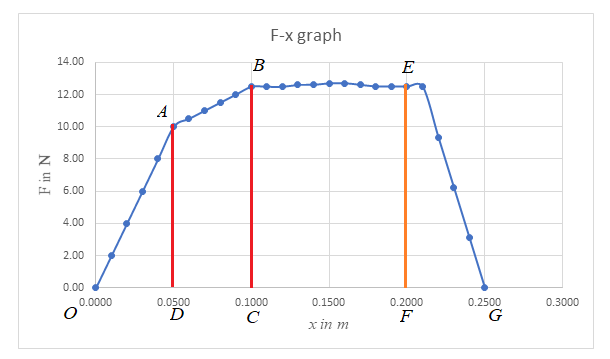
Concept explainers
(a)
The work done in the first 0.100 m by plotting a graph between F and x.
Answer to Problem 37QAP
The work done in the first 0.100 m is 0.812 J.
Explanation of Solution
Given:
The values of x and F.
| x (m) | F (N) |
| 0.0000 | 0.00 |
| 0.0100 | 2.00 |
| 0.0200 | 4.00 |
| 0.0300 | 6.00 |
| 0.0400 | 8.00 |
| 0.0500 | 10.00 |
| 0.0600 | 10.50 |
| 0.0700 | 11.00 |
| 0.0800 | 11.50 |
| 0.0900 | 12.00 |
| 0.1000 | 12.48 |
| 0.1100 | 12.48 |
| 0.1200 | 12.48 |
| 0.1300 | 12.60 |
| 0.1400 | 12.60 |
| 0.1500 | 12.70 |
| 0.1600 | 12.70 |
| 0.1700 | 12.60 |
| 0.1800 | 12.50 |
| 0.1900 | 12.50 |
| 0.2000 | 12.50 |
| 0.2100 | 12.48 |
| 0.2200 | 9.36 |
| 0.2300 | 6.24 |
| 0.2400 | 3.12 |
| 0.2500 | 0.00 |
Formula used:
Using an excel sheet, a graph is plotted between F and x and the work done is calculated by determining the area under the curve for the displacement under consideration.
Calculation:
Enter the values of x and F in an excel sheet and plot a graph as shown below.

For the displacement of 0.1 s, calculate the area under the curve.

The work done during the displacement of 0.1 s is equal to area OABC.
Calculate the area of the figure OABC.
Substitute the values of the variables from the graph in the above equation.
Conclusion:
Thus, the work done in the first 0.100 m is 0.812 J.
(b)
The work done in the first 0.200 m by plotting a graph between F and x.
Answer to Problem 37QAP
The work done in the first 0.200 m is 2.06 J.
Explanation of Solution
Given:
The values of x and F.
| x (m) | F (N) |
| 0.0000 | 0.00 |
| 0.0100 | 2.00 |
| 0.0200 | 4.00 |
| 0.0300 | 6.00 |
| 0.0400 | 8.00 |
| 0.0500 | 10.00 |
| 0.0600 | 10.50 |
| 0.0700 | 11.00 |
| 0.0800 | 11.50 |
| 0.0900 | 12.00 |
| 0.1000 | 12.48 |
| 0.1100 | 12.48 |
| 0.1200 | 12.48 |
| 0.1300 | 12.60 |
| 0.1400 | 12.60 |
| 0.1500 | 12.70 |
| 0.1600 | 12.70 |
| 0.1700 | 12.60 |
| 0.1800 | 12.50 |
| 0.1900 | 12.50 |
| 0.2000 | 12.50 |
| 0.2100 | 12.48 |
| 0.2200 | 9.36 |
| 0.2300 | 6.24 |
| 0.2400 | 3.12 |
| 0.2500 | 0.00 |
Formula used:
Using an excel sheet, a graph is plotted between F and x and the work done is calculated by determining the area under the curve for the displacement under consideration.
Calculation:
The F-x graph is shown below:

The work done during the displacement of 0.200 m is given by the area OABEF.
Assume an average value of Force as 12.50 N during the displacement from 0.100 m to 0.0200 m.
Substitute the values of the variables from the graph in the above equation.
Conclusion:
Thus, the work done in the first 0.200 m is 2.06 J.
(c)
The work done during the displacement from 0.100 m to 0.200 m by plotting a graph between F and x.
Answer to Problem 37QAP
The work done during the displacement from 0.100 m to 0.200 m is 1.25 J.
Explanation of Solution
Given:
The values of x and F.
| x (m) | F (N) |
| 0.0000 | 0.00 |
| 0.0100 | 2.00 |
| 0.0200 | 4.00 |
| 0.0300 | 6.00 |
| 0.0400 | 8.00 |
| 0.0500 | 10.00 |
| 0.0600 | 10.50 |
| 0.0700 | 11.00 |
| 0.0800 | 11.50 |
| 0.0900 | 12.00 |
| 0.1000 | 12.48 |
| 0.1100 | 12.48 |
| 0.1200 | 12.48 |
| 0.1300 | 12.60 |
| 0.1400 | 12.60 |
| 0.1500 | 12.70 |
| 0.1600 | 12.70 |
| 0.1700 | 12.60 |
| 0.1800 | 12.50 |
| 0.1900 | 12.50 |
| 0.2000 | 12.50 |
| 0.2100 | 12.48 |
| 0.2200 | 9.36 |
| 0.2300 | 6.24 |
| 0.2400 | 3.12 |
| 0.2500 | 0.00 |
Formula used:
Using an excel sheet, a graph is plotted between F and x and the work done is calculated by determining the area under the curve for the displacement under consideration.
Calculation:
The F-x graph is shown below:

The work done during the displacement from 0.100 m to 0.200 m is given by the area BEFC.
Assume an average value of Force as 12.50 N during the displacement from 0.100 m to 0.0200 m.
Substitute the values of the variables from the graph in the above equation.
Conclusion:
Thus, the work done during the displacement from 0.100 m to 0.200 m is 1.25 J.
(d)
The work done during the entire motion
Answer to Problem 37QAP
The work done during the entire motion
Explanation of Solution
Given:
The values of x and F.
| x (m) | F (N) |
| 0.0000 | 0.00 |
| 0.0100 | 2.00 |
| 0.0200 | 4.00 |
| 0.0300 | 6.00 |
| 0.0400 | 8.00 |
| 0.0500 | 10.00 |
| 0.0600 | 10.50 |
| 0.0700 | 11.00 |
| 0.0800 | 11.50 |
| 0.0900 | 12.00 |
| 0.1000 | 12.48 |
| 0.1100 | 12.48 |
| 0.1200 | 12.48 |
| 0.1300 | 12.60 |
| 0.1400 | 12.60 |
| 0.1500 | 12.70 |
| 0.1600 | 12.70 |
| 0.1700 | 12.60 |
| 0.1800 | 12.50 |
| 0.1900 | 12.50 |
| 0.2000 | 12.50 |
| 0.2100 | 12.48 |
| 0.2200 | 9.36 |
| 0.2300 | 6.24 |
| 0.2400 | 3.12 |
| 0.2500 | 0.00 |
Formula used:
Using an excel sheet, a graph is plotted between F and x and the work done is calculated by determining the area under the curve for the displacement under consideration.
Calculation:
The F-x graph is shown below:

The work done during the entire displacement is given by the area OABEG.
Substitute the values of the variables from the graph in the above equation.
Conclusion:
Thus, the work done during the entire motion
Want to see more full solutions like this?
Chapter 6 Solutions
College Physics Volume 2
- Give an example of a situation in which there is a force and a displacement, but the force does no work. Explain why it does no work.arrow_forwardConsider a particle on which a force acts that depends on the position of the particle. This force is given by . Find the work done by this force when the particle moves from the origin to a point 5 meters to the right on the x-axis.arrow_forwardA block of mass m = 2.50 kg is pushed a distance d = 2.20 m along a frictionless horizontal table by a constant applied force of magnitude F = 16.0 N directed at an angle = 25.0 below the horizontal as shown in Figure P5.8. Determine the work done by (a) the applied force, (b) the normal force exerted by the table, (c) the force of gravity, and (d) the net force on the block. Figure P5.8arrow_forward
- If the net work done by external forces on a particle is zero, which of the following statements about the particle must be true? (a) Its velocity is zero. (b) Its velocity is decreased. (c) Its velocity is unchanged. (d) Its speed is unchanged. (e) More information is needed.arrow_forwardConsider a particle on which several forces act, one of which is known to be constant in time: . As a result, the particle moves along the x-axis from x=0 to x=5 m and then parallel to the y-axis from y=0 to y=6 m. What is the work done by ?arrow_forwardThe surface of the preceding problem is modified so that the coefficient of kinetic friction is decreased. The same horizontal force is applied to the crate, and after being pushed 8.0 m, its speed is 5.0 m/s. How much work is now done by the force of friction? Assume that the crate starts at rest.arrow_forward
- A block of mass m = 2.50 kg is pushed a distance d = 2.20 m along a frictionless, horizontal table by a constant applied force of magnitude F = 16.0 N directed at ail angle = 25 below the horizontal as shown in Figure P7.5. Determine the work done on the block by (a) the applied force, (b) the normal force exerted by the table, (c) the gravitational force, and (d) the net force on the block.arrow_forwardA block of mass m = 2.50 kg is pushed a distance d = 2.20 m along a frictionless, horizontal table by a constant applied force of magnitude F = 16.0 N directed at an angle = 25.0 below the horizontal as shown in Figure P6.3. Determine the work done on the block by (a) the applied force, (b) the normal force exerted by the table, (c) the gravitational force, and (d) the net force on the block. Figure P6.3arrow_forwardThe force acting on a particle is Fx = (8x 16), where F is in newtons anti x is in meters. (a) Make a plot of this force versus x from x = 0 to x = 3.00 m. (b) From your graph, find the net work done by this force on the particle as it moves from x = 0 to x = 3.00 m.arrow_forward
- The force acting on a panicle varies as shown in Figure la P7.14. Find the work done by the force on the particle as it moves (a) from x = 0 to x = 8.00 m. (b) from x = 8.00 m to x = 10.0 m, and (c) from x = 0 to x = 10.0 m.arrow_forwardA block of mass m = 2.50 kg is pushed a distance d = 2.20 m along a frictionless horizontal table by a constant applied force of magnitude F = 16.0 N directed at an angle = 25.0 below the horizontal as shown in Figure P5.8. Determine the work done by (a) the applied force, (b) the normal force exerted by the table, (c) the force of gravity, and (d) the net force on the block. Figure P5.8arrow_forwardA particle is subject to a force Fx that varies with position as shown in Figure P7.9. Find the work done by the force on the particle as it moves (a) from x = 0 to x = 5.00 m, (b) from x = 5.00 m to x = 10.0 m, and (c) from x = 10.0 m to x = 15.0 m. (d) What is the total work done by the force over the distance x = 0 to x = 15.0 m?arrow_forward
 College PhysicsPhysicsISBN:9781285737027Author:Raymond A. Serway, Chris VuillePublisher:Cengage Learning
College PhysicsPhysicsISBN:9781285737027Author:Raymond A. Serway, Chris VuillePublisher:Cengage Learning Principles of Physics: A Calculus-Based TextPhysicsISBN:9781133104261Author:Raymond A. Serway, John W. JewettPublisher:Cengage Learning
Principles of Physics: A Calculus-Based TextPhysicsISBN:9781133104261Author:Raymond A. Serway, John W. JewettPublisher:Cengage Learning University Physics Volume 1PhysicsISBN:9781938168277Author:William Moebs, Samuel J. Ling, Jeff SannyPublisher:OpenStax - Rice University
University Physics Volume 1PhysicsISBN:9781938168277Author:William Moebs, Samuel J. Ling, Jeff SannyPublisher:OpenStax - Rice University Physics for Scientists and Engineers, Technology ...PhysicsISBN:9781305116399Author:Raymond A. Serway, John W. JewettPublisher:Cengage Learning
Physics for Scientists and Engineers, Technology ...PhysicsISBN:9781305116399Author:Raymond A. Serway, John W. JewettPublisher:Cengage Learning Physics for Scientists and Engineers with Modern ...PhysicsISBN:9781337553292Author:Raymond A. Serway, John W. JewettPublisher:Cengage Learning
Physics for Scientists and Engineers with Modern ...PhysicsISBN:9781337553292Author:Raymond A. Serway, John W. JewettPublisher:Cengage Learning College PhysicsPhysicsISBN:9781305952300Author:Raymond A. Serway, Chris VuillePublisher:Cengage Learning
College PhysicsPhysicsISBN:9781305952300Author:Raymond A. Serway, Chris VuillePublisher:Cengage Learning





